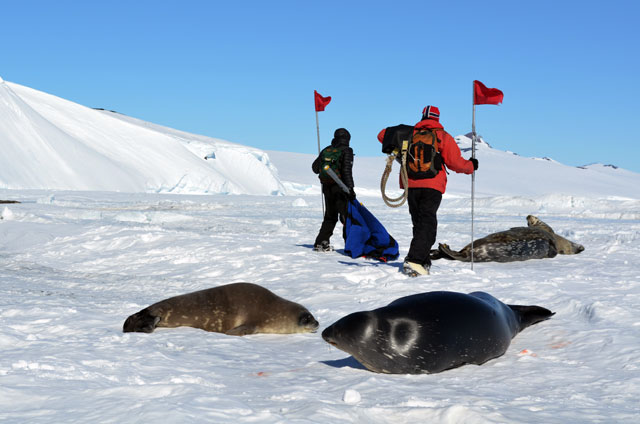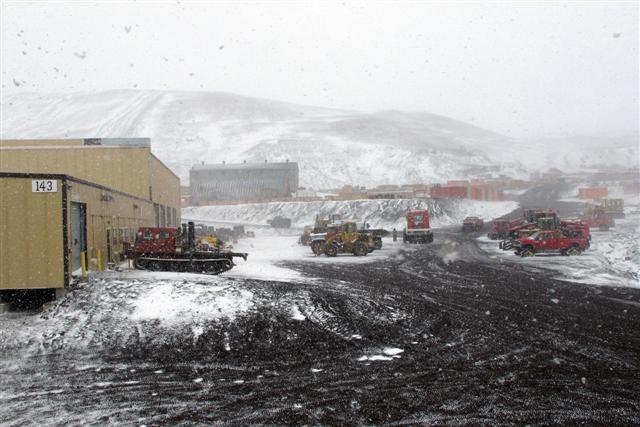|
McMurdo Station Archives - 2011 McMurdo moves into next phase of summer season as sea ice ops wrap upPosted December 9, 2011
McMurdo Station Every week the U.S Air Force C-17 brings in new groups of scientists. By the end of the month, there were about 170 researchers in town and another 70 in various field camps far and wide. About a dozen field camps are supported by helicopter, and nearly an equal number by fixed-wing aircraft. Terry Wilson The WAIS Divide Closer to McMurdo Station, science groups worked on the sea ice to collect specimens for ocean acidification studies on fish and sea urchins. Other teams are conducting studies on Weddell seals, from a long-term population study that dates back to the 1960s to a first-year project to study how the pinnipeds regulate heat in an icy environment. 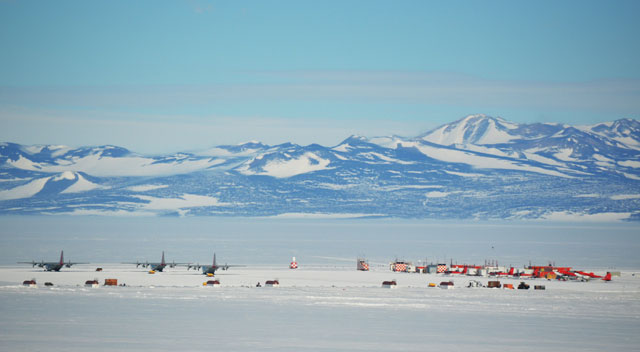
Photo Credit: Peter Rejcek
The sea ice runway the week before the airfield was relocated to Pegasus.
As always, weather was a big wild card, with bluebird skies and warm temperatures early in November, which caused McMurdo’s blanket of snow to fray, revealing the brown volcanic dirt and rock underneath. However, a mid-month series of storms moved across the region, freshening the snow but causing numerous disruptions in the helicopter and plane schedules. That meant delays getting scientists to field camps. It also meant almost no fresh vegetables for the annual Thanksgiving feast. But the galley performed its usual holiday magic, serving up turkey and ham, with all of the trimmings, including dozens of pumpkin and pecan pies. The milder than normal temperatures kept the sea ice runway and the snow road from Ross Island to the airfield in relatively good condition. Preparations were made for the upcoming move from the sea ice runway to Pegasus airfield, which requires hauling the entire facility onto the permanent ice shelf. No amount of mild weather will help the new ice pier this year, which never got thick and solid enough over its construction during the winter because of above-average temperatures. The pier is needed to transfer fuel and cargo from vessels that will arrive at McMurdo in January. Contingency plans are currently being developed, with the most likely scenario involving installation of a modular causeway, a temporary floating pier, by the U.S. Army. McMurdo activity ramps up with beginning of summer field seasonPosted November 11, 2011
The 2011-12 summer field season at McMurdo Station That was partly due to weather, which played its usual havoc with flight schedules between Christchurch and McMurdo, as well as later flights between McMurdo and the South Pole Station 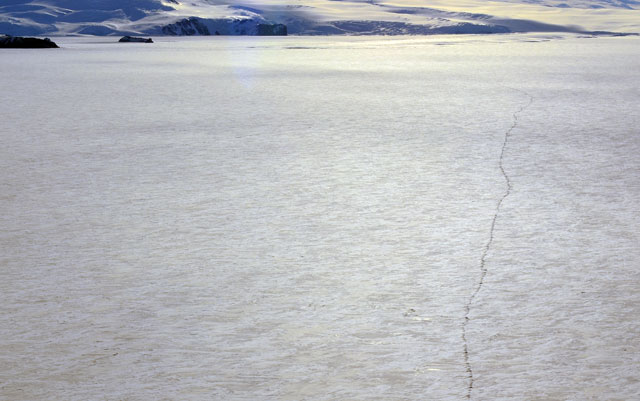
Photo Credit: Peter Rejcek
Cracks in the sea ice, such as the one at the right, have caused some logistical challenges for science operations.
However, toward the end of the month, the population had hit more than 900 people, some of them awaiting transport to South Pole, which received its first flight of the summer on Oct. 24, a week later than planned because of poor weather on the continent. October in McMurdo has also proven to be a tough place for driving, as well as flying. Large cracks in the nearby sea ice have limited researchers from accessing traditional study sites. For example, principal investigator Robert Garrott’s Sea ice conditions are significantly different this season after all the ice blew out of McMurdo Sound, the first time in about a decade. Slightly warmer temperatures over the winter also played a role, resulting in more active cracks than in seasons past. However, toward the end of the month, sea ice conditions improved somewhat, as cooler temperatures prevailed, with several cracks freezing solid enough to allow tracked vehicles to access some areas. The cooler weather also helped ongoing efforts to build a new ice pier, which has been slowed by warmer-than-normal temperatures over the winter and spring. That’s all good news for the 17 research groups, representing more than 60 scientists, which were on station near the end of the month. The first of the scientists with the McMurdo Dry Valleys Long Term Ecological Research (LTER) Meanwhile, penguin research Paul Ponganis McMurdo Station personnel begin early-season activitiesPosted October 21, 2011
September was a very busy month at McMurdo Station Heavy equipment operators from our Fleet Operations department were occupied with constructing a new runway on the sea ice, as well as completing road maintenance on the McMurdo Ice Shelf to the launch site of the Long Duration Balloon 
Photo Credit: DigitalGlobe/Antarctic Photo Library
A satellite image of Ross Island, the sea ice runway (straight down from the tip of the island) and the Long Duration Balloon facility at Williams Field (to the right of the island).
The sea ice proved to be a real challenge for the grantees and equipment operators throughout September. Due to a combination of factors — late winter formation, warmer temperatures, heavy snowfall, and windy storm systems — the ice has formed many cracks. Specific research areas to our north, such as the sea ice edge near Cape Royds and the region around Cape Evans, have been blocked off by large cracks prohibiting safe passage. These conditions have been particularly challenging for the two-person science team of Jeff Bowman and Shelly Carpenter, who are collecting delicate frost flowers, which form at the edge of the sea ice. [See related article: Full bloom.] However, the team from the University of Washington Meanwhile, carpenters worked steadily on projects such as building fish huts, a berthing sled for the South Pole Operations Traverse crew, and crates for the deep-field camps and traverses. People were busy completing their field safety and vehicle operation training. Also, our helicopter mechanics from PHI (Petroleum Helicopter, Inc.) Slowly and steadily, McMurdo gets ready for the summer. McMurdo crews busy creating roads and building ice pierPosted September 23, 2011
The Winter Fly-in period, called WinFly for short, officially began in August. Over the span of two weeks, seven scheduled U.S. Air Force Globemaster III C-17 flights brought an influx of people and cargo to McMurdo Station Weather windows would come and go, and this made it a little tricky for the Air Force to land their planes safely. It definitely kept cargo crews, heavy equipment drivers, airfield ground equipment personnel and firefighters busy, as they continually maintained Pegasus airfield Incoming scientists and support personnel spent extra days in Christchurch, New Zealand, while they patiently waited for news of good weather. On the flip side, everyone here on station patiently waited for colleagues and friends to arrive to begin helping with the massive task list of final preparations for the summer science season. 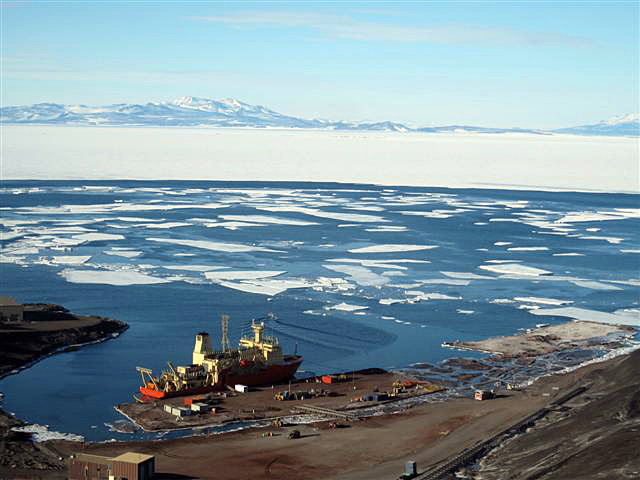
Photo Credit: Jeff Scanniello/Antarctic Photo Library
The research vessel Nathaniel B. Palmer docked at the McMurdo Station ice pier earlier this year before the pier broke apart, requiring construction of a new one over the winter.
The two science groups that arrived here during WinFly got to work right away. Divers from Adam Marsh’s The freshly reinforced Fleet Operations department has been busy creating a road out to the site of a new Ice Runway to be built before the summer Mainbody season in early October. There is a giant crack in the sea ice that forms each year in front of McMurdo. Historically, it has been a manageable crack for vehicles to cross, but this year it is so large that an end-run road around the crack is required to get to a newly surveyed site for the runway. Work also continued on a new ice pier to replace the one that broke apart at the end of last summer season, partly thanks to some powerful storms that helped clear out the sea ice in McMurdo Sound. Relatively warm temperatures over the winter have slowed progress, as crews work to thicken the ice before the arrival of the icebreaker, cargo and fuel vessels in January. There’s definitely no lack of work to do as the summer field season rapidly approaches. The first flight of Mainbody is scheduled for Oct. 3. Late winter storms bury McMurdo before the arrival of first flightsPosted August 12, 2011
The month of July came in with a bang and went out with a blow here at McMurdo Station Even surrounded by darkness and cold, McMurdo residents managed to conjure the true feel of an Independence Day festival within the confines of the VMF (Vehicle Maintenance Facility). The inside of the maintenance shop — usually filled with trucks, dozers and cranes in various stages of repair — was converted into a full-fledged carnival, including games of chance, photo booths and a dunking tank. Traditional carnie foods were offered, such as corn dogs and fried dough. Four different types of chili vied for the title of Best Chili in the cook-off. In a show of community spirit, donations were taken throughout the evening to help two dear friends who had to cut their season short due to the medevac in late June. All red, white and blue aside, it was this outpouring of generosity for our fellow winter-overs that really made the evening memorable. Not to be outdone, the Waste department hosted a party of its own to usher out the month, transforming the Waste Barn (which is normally used for housing and sorting trash tri-walls) into Bob’s Country Bunker and Roadhouse, complete with a western bar and swinging saloon doors for a real country hoedown. Taking center stage was the multitude of talented bands that have made up the strong musical core of the winter: Uncle Skeeter’s Freeform Amalgam, Johnny’s Rebels, Tears for Piers (an all-girl rock band) and The Kountry Rainbows, each bringing new, country-themed songs to the stage for everyone’s enjoyment. And what hoedown would be complete without a good old-fashioned barbeque? Burgers and corn on the cob from the grill, served throughout the evening, really made the transformation complete. The real headliners for the month of July, however, were the series of storms that pounded the station with high snowfall and gale-force winds. At McMurdo Station, weather is classified into three categories, depending on its severity: Condition 3, Condition 2 and Condition 1, with the last being the most severe weather due to cold temperatures, high winds, and/or low visibility. During a Condition 1 event, normal station operations are suspended, and movement outside is limited to essential travel, with escorts from the search and rescue (SAR) team. 
Photo Credit: Kelly Speelman/Antarctic Photo Library
Nacreous clouds above McMurdo Station. The clouds are involved in the chemical processes in the atmosphere that cause ozone loss above Antarctica, which begins in the austral spring.
Over the past several weeks, the station has been hit with several bouts of Condition 1 weather. According to weather forecaster Christine Blais, these storms and the overall pattern of unsettled weather are normal for this time of year, as the weather patterns shift in the upper atmosphere due to the springtime movement of the Earth’s axis that brings back the faint glow of sunshine on our horizon. Just as the United States has been stuck under a pattern of severe hot weather for several weeks, McMurdo experienced its most bitterly cold temperatures the weeks prior to the latest round of storms. As this system broke, warmer temperatures of up to 23 degrees Fahrenheit moved in. These warm temperatures, coupled with the volatile upper atmosphere unrest, brought heavy snow and high winds. Weather observer Angela Garner reported that the estimated total snowfall over the course of the two storms was almost five feet. Coupled with sustained winds of 70 miles per hour, with gusts reaching 83 mph, we had some really nasty weather outside! While we all reveled in the exciting storms and the change from daily routines, no one was excited about the sheer tonnage of snow that had to be moved once the weather had settled down. Besides causing visibility issues, those high winds also caused mountainous drifts to form all over the station by carrying snow from the nearby ice shelf. McMurdo residents banded together with shovels to help one another clear doorways and pathways. Kudos should be given to Bob Teuscher and his Fleet Operations team, as they once again spent countless hours manning the heavy equipment it takes to move those mountains of snow away from the station. With yet another storm raging outside as this article is being written, McMurdo braces itself for another few days of shoveling and snow clearing. We look toward the horizon for a break in the seemingly endless line of storms for a glimpse of the evasive sun that has been hidden for so many months. While we have all seen the ever-lightening glow of the sky around us, the true sunrise, with the sun making a brief appearance above the horizon, will take place in just a few short weeks on Aug. 19. This will be both the symbolic end to a long winter and the official one, as the first flight of WinFly will occur the following day, bringing in a plane full of new people — presumably to help with the shoveling. McMurdo Station supports successful winter medical evacuationPosted July 15, 2011
It was the winter solstice of 1911 in Antarctica when the crews of Capt. Robert F. Scott, Roald Amundsen, and other explorers around the continent pulled out all of their best food and clothes to celebrate the impending return of the sun. They dined, played music, danced, and enjoyed a holiday that most people in the world overlooked. June 21 was especially significant to these men because it marked the turn of the winter and the slow return of light to this frigid landscape. The following Antarctic summer, Scott and Amundsen set out on their famous and fateful race to the South Pole. 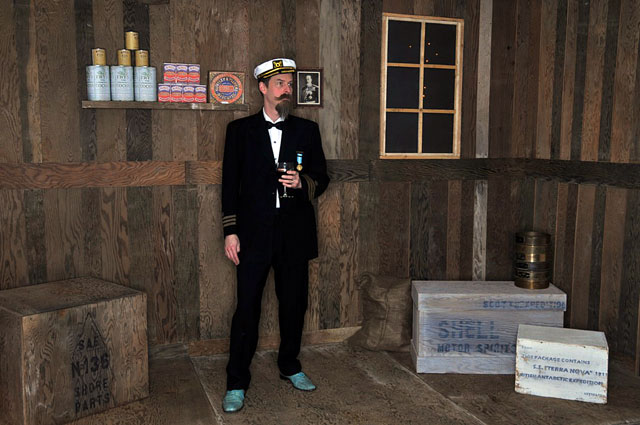
Photo Courtesy: Daniel Jennings
Daniel Jennings poses in his Capt. Scott outfit in a replica of the explorer's hut that Jennings built for the Midwinter festivities.
Here, in 2011, the centennial significance of that event was especially felt as the residents of McMurdo Station Nearly every single person on station lent a hand for the festival, and the warm camaraderie abounded as friends joined to eat and dance together. The station cooks spoiled us with an amazing menu including lobster bisque, tea-smoked duck, coconut-infused halibut, duchesse potatoes with truffle caviar, cheesecake, and a whole lot more tasty goodness to stuff our stomachs. As the official event winded down, many of the station personnel retired to our friendly neighborhood pub Gallagher’s to continue the celebration and enjoy the silly entertainment of McMurdo’s only hip-hop dance troupe, the Kool Kids. I wonder how Capt. Scott would have reacted to seeing such dancing on this frozen island a full century after his own night of mirth and revelry. There are no doubts that the good Captain would have approved. 
Photo Credit: Jereld MacGregor
A member of the Pegasus airfield ground crew directs an Air Force C-17 airplane during the winter medical evacuation.
June was a busy month for most all departments here, yet life stayed pretty quiet and steady in the few weeks before the winter solstice. During the last week of the month, however, nearly every single department on station put its tasking on hold to help accomplish a very significant mission. A friend of ours had become very ill and needed a medical evacuation to Christchurch, New Zealand, for additional care. With deliberate resolve and teamwork, we brought the runway at the Pegasus airfield online to receive a medical crew aboard a U.S. Air Force C-17 airplane. The aircraft flew down to the dark Antarctic and landed safely with the aid of night-vision goggles to pick up our friend. See Air Force news story The midwinter medevac mission was a huge success, and the reward for everyone’s hard work was not insignificant, as a pallet with some 6,000 pounds of fresh fruit, vegetables and mail was also offloaded for the residents of McMurdo and New Zealand’s Scott Base McMurdo Station winter personnel pursue plenty of recreational opportunitiesPosted June 24, 2011
While May flowers are popping up in the northern hemisphere, the month of May blew by McMurdo Station Always a busy place, McMurdo Station has been hopping this year with the addition of our new recreation coordinator, Gracie Sorbello. A master at juggling a schedule and the many unique interests of our diverse population, Gracie, along with many other stellar volunteers, has managed to pack each week with recreational events, ranging from the intellectually sublime to the raucously competitive. During the winter, our daily tasking is very routine. Unlike the summer season, which is full of scientists and the busy movements of people across the continent, winter moves at a slower and steadier pace. 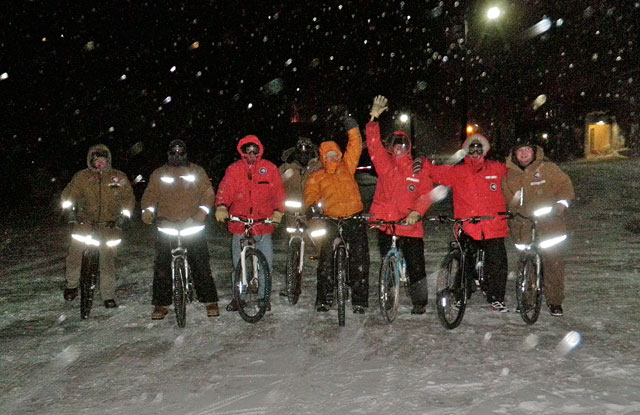
Photo Credit: Jeff Kennett
McMurdo personnel pause during Bike to Work Day (held in conjunction with the one in Denver) for a group shot. Temperatures with windchill were minus 47 degrees Fahrenheit.
The role of the winter staff is to repair and recover the station from the wear and tear of the massive summer population, while making all the preparations needed to welcome back the hustle and bustle of science for the next field season. The necessary tasks of painting walls, fixing floors, organizing scientific equipment, and counting and receiving endless milvans of new stock and inventory give way to recreational pursuits in the off-hours. Those with a competitive streak have many ways to put it to good use through regular game nights and tournaments. The crew at the Vehicle Maintenance Facility hosted a horseshoes tournament in the shop, pitting both expert throwers and inexperienced newbies against one another in double-elimination play. A cribbage tournament brought out the card shark in many, with a large number of the population signing up to play. There have also been darts tournaments, as well as a weekly game night for those more interested in games of strategy over games of skill. For those looking for more intellectual pursuits, there are no lack of opportunities to expand and edify their minds. One option includes “TED talks,” a series of short videos featuring the great minds of society discussing topics that they are passionate about. Four short “lectures” are presented each week in the galley to a sizeable crowd, with the opportunity for discussion afterwards. There is also a weekly documentary and discussion night, ranging from environmental issues to politics. The coffee house also offers an independent film series on Sunday afternoons. Combined with multiple trivia nights each month, our minds are constantly being exercised. May brought some extra-special events as well. Blessed with a bevy of talented photographers this season, a special Mother’s Day photo booth was offered on May 10 to allow people to send special photos of themselves to their mothers. Resident weather forecaster Christine Blais offered a science lecture called Antarctic Weather 101. Classes were also offered in construction planning and grade setting, Linux operating systems and beginning Chinese. 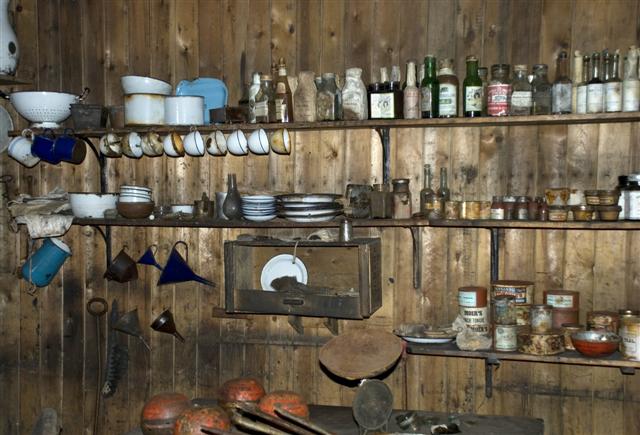
Photo Credit: Ralph Maestas/Antarctic Photo Library
The kitchen at the Cape Evans historic hut where conservators are working to preserve artifacts from the early explorers.
The conservators working for the Antarctic Heritage Trust The annual Wine Tasting event was held this month in the library. A regular event for the last several years, the tasting allowed us to sample some of the various wines that have been purchased for future sale in the store. Always an elegant affair, residents gathered to taste six different wines, while munching on delectable appetizers from the galley and listening to the talented musical stylings of many local musicians. Emily Woodward, our greenhouse technician, opened up the greenhouse to offer “Picnics in the Park,” as an extra-special treat in the middle of winter. Working with the recreation office and the galley, lunchtime shuttles and bag lunches were provided to allow people to dine “al fresco” in the greenhouse, soaking up the full spectrum lighting and the humidity. The event allowed people to forget momentarily the dark and blustery environment just beyond the greenhouse walls. We rounded out the month with a Memorial Day celebration, remembering all those who have given their lives in military service to our country. Photos were collected from the community depicting the military service of current personnel, as well as family members. The pictures were displayed in a slide show on one of the local television channels. Everyone in the community was also invited to an outdoor ceremony at the MacOps building, above which the American flag flies throughout the winter. There were some speeches, and at 3 p.m., the flag was lowered and taps was played. Afterward, people gathered in the galley to partake of a special cake baked by Josie MacLeod, the winter baker. Night sky lights up at McMurdo StationPosted May 13, 2011
The month of April marked the time in which we at McMurdo Station On clear days, many a constellation can be identified as the stars, planets and satellites seem to pop out in contrast to a darkened sky not tainted by the bright lights of civilization. An astronomy club has just been created, with interested members sharing their knowledge of the celestial bodies that make up the southern sky. On that last day of official sunlight, April 24, many of the inhabitants of McMurdo ascended to the ridges above town and out to Castle Rock to catch one final glimpse of the sun, as it briefly peeked over Cape Royds to the north. Twilight quickly returned, and now it won’t be long until it’s completely dark. With the much smaller winter population, many unneeded and unused buildings were shut down and winterized to save energy over the winter. Dorm buildings, cargo centers and science-oriented buildings stand dark and cold now, awaiting the flurry of activity that will once again bring them to life in August. The station heroes of April have emerged in the form of our plumbers and electricians from the Facilities, Engineering and Maintenance department (a.k.a., FEMC). Frozen pipes all over station have proven to be a true test for these workers, and they’ve risen to the challenges, as they work to integrate our newly installed heat trace system. Facebook updates were also frozen in time in April when the Internet at McMurdo was knocked out for nearly a week. McMurdo receives its access to the Internet by way of satellite antenna staged on a nearby island called Black Island, some 50 miles south. After a party of engineers and mechanics returned from some routine maintenance at the facility — requiring a “traverse” across the ice shelf on tracked vehicles — they had to return quickly at the sudden news that the antenna’s batteries were not charging by either the generators or the wind turbines on site. The facility went into power-saving mode, causing the Internet to shut down until the team could get back there to assess the situation. Though unavailable parts are demanding creative solutions for the problems at Black Island, the IT department and power plant crewmembers will surely be recognized as the heroes of May for getting us back online. April also offered some recreational distractions, highlighted by the station’s annual Fashion Show put on by store manager Keri Nelson and a group of volunteers constituting 31 percent of the winter population. Every year, our little station store receives a new stock of Antarctic-themed apparel to sell to the folks on station. In an effort to share the new and upcoming apparel, the store hosts a fashion show based loosely on the popular reality TV show “America’s Next Top Model.” This year’s event included its own Internet blog, model backstories illustrated through Internet video webisodes, a catwalk, and a choreographed cage match to decide the winner. There were even special “visits” by eclectic, visionary fashion experts from around the world, such as the very European Estrid Zeta (Karen Hagerman of the Berg Field Center), a frighteningly ornamented Judge Roy Bean (NSF manager Bill Henriksen), and the brightly illumined Fifi Chamonix (greenhouse technician Emily Woodward). So, life at McMurdo is surely packed full of fun and adventure right now. With continued heroic efforts by our FEMC tradesmen, our IT engineers, and our fabulously good-looking people down here, we’ll surely be able to take on any surprises that May reveals — and, with luck, we’ll hopefully be able to tell you about it all on Facebook. Winter season officially begins at McMurdoPosted April 8, 2011
It’s official. In March, the winter-over crew at McMurdo Station There were many official events last month. The Fleet Operations and Fuels departments officially closed the Pegasus airfield What’s more, the “new” one-year-old ice pier has been officially released from its mooring, too. During the months of February and March, the pier cracked up into so many pieces (the last count was nine), that it was decided to let it go, and build a new ice pier from scratch. The operation of moving the pier out of the way became a bit too tricky when wind and currents pulled it out of control, breaking apart a few of its mooring cables. It slowly rotated around and nearly blew all the way out to sea, too, leaving only one cable left to tie it to shore. The Fleet Operations crew, along with safety assistance from the Winter Search and Rescue team, set up new rigging cables to re-secure the pier, but unfavorable weather and a widening gap between pier and shore prevented the team from safely spanning across. The pier is now at the mercy of Mother Nature. If a favorable wind blows it back toward the shore, we will move across to secure it. Otherwise, it may continue to drift farther away, along with its bollards, a tractor-trailer, and a Quonset hut. With luck, the pier won’t drift too far from station, and many of the parts will be salvageable for re-use. If you haven’t gotten the drift already — no pun intended — the Fleet Operations crew has their hands officially full this winter. The task sheet includes grooming a new nine-mile-long ice road to the Pegasus airfield, constructing an entirely new ice pier, and also repairing the traverse route to the neighboring satellite communications buildings on Black Island (all during the dark of winter). Aside from these big tasks ahead, the station is settling into its winter groove. Recreation events are starting to pop up around town. The evenings are filled with bingo, karaoke, trivia nights, yoga classes, American Night at Scott Base One of the biggest recreation highlights in March was the 5K Shamrock Shuffle fun run to celebrate St. Patrick’s Day. The weather could not have been more perfect for the event, as participants ran along the road to New Zealand’s Scott Base and back. The stellar views of open water around Scott Base and Cape Armitage only added to the fun. We have an all-star cast of cooks in the kitchen, and we’re eating in high fashion these days. I’ve always been a big fan of McMurdo’s legendary Sunday brunches during the summer, but the Sunday brunches of winter have kicked it up to a completely new level. To combat the effects of inevitable weight gain from all of the amazing food produced in the McMurdo kitchen, the station has implemented a Biggest Loser weight loss challenge to the community. The effects of open water in McMurdo Sound continue to amaze folks. This is especially true in combination with the beautiful lighting, as the sun sinks lower and lower in the sky. All it takes is glance toward the Royal Society mountain range across the open waters of McMurdo Sound to inspire a true sense of awe and gratitude for this place in which we work. The mountains are almost perpetually in a state of alpenglow these days, and crazy fogs and foreground wind effects over the open water make it truly a remarkable sight. The open water is still inviting penguin visitors to the station, and even the occasional whale. For a while, one could walk over near the ice edge at Scott Base to watch emperor penguins swim together and listen to the alien-sounding vocalizations of the Weddell seals as they played beneath the fast ice. It is quite an opportunity to experience the “wild” side of living in this far-flung polar region. Astronomically speaking, we officially went into winter with the passing of the austral Autumnal Equinox. We are now experiencing more darkness than light each day, and it’s only going to get darker down here. Let the fun officially begin. Transition into winter particularly challenging at McMurdoPosted March 11, 2011
Once again, the month of February marks the shift from a busy summer season to a long winter here at McMurdo Station Returning winter-overs like me come prepared to deal with a certain amount of uncertainty and disarray in this hectic period: temporary housing; the eager wait to be assigned a winter room; turnover within departments; and the “handing over of the reins” from one crew to another. However, this not a typical year, and it will always be remembered for some key deviations from its normal path. February was busier than most, with several ships passed through McMurdo’s little-visited harbor other than the normal icebreakers and re-supply ships. In early February, the research vessel Nathaniel B. Palmer 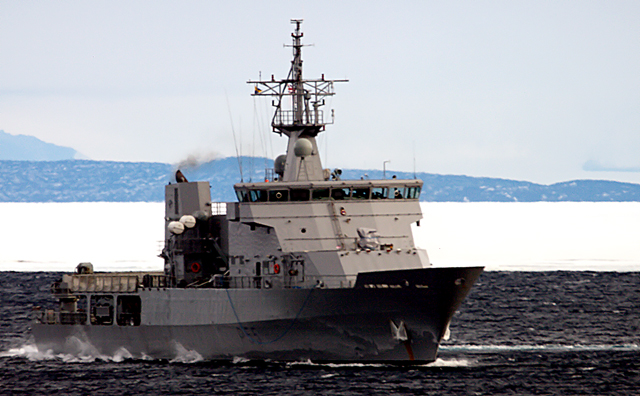
Photo Credit: MIchael Patterson
The HMNZS Wellington, a patrol vessel in the Royal New Zealand Navy, in McMurdo Sound.
Many of the replacement crewmembers for the Palmer flew to the ice with the deploying winter crew, allowing us to form new friendships, and we were treated to tours of the vessel while it was in port. Although it did not make McMurdo an official port of call, the ill-fated adventure vessel Berserk out of Norway visited the harbor to drop off a shore party near New Zealand’s Scott Base And, just a few days ago, McMurdo Station welcomed guests from the Enderby, an Antarctic cruise vessel hailing from New Zealand. After several date changes due to weather, the tour group made shore on Feb. 27 and were treated to tours of the station’s lab and store, along with visits to Robert F. Scott’s historic hut and Scott Base. Mother Nature seemed determined this month to make the summer/winter transition a tumultuous one. The entire U.S. Antarctic Program Serving as the New Zealand logistics base for USAP operations at McMurdo and South Pole At the same time we were absorbing the news of the earthquake in Christchurch, McMurdo Station was also bracing itself to deal with a bout of major storms on the home front. High winds and heavy snow mandated the calling of the first Condition 1, the designation for the most severe weather, of the winter. Some of the last remaining flights of the summer season were put on hold for several days as we waited out the storm, before we banded together to dig out from the heavy snowfall. The high winds also created big sea swells in the already open water just in front of station, causing major sections of the semi-permanent ice shelf to break free and float out to sea. 
Photo Credit: Michael Patterson
The research vessel Nathaniel B. Palmer docks at the ice pier near McMurdo Station.
This has caused the open water to encroach upon the major thoroughfare between the Ross Island research stations and the Pegasus airfield. The waves also caused damage to the ice pier that recently served as a dock for the Palmer. The pier, which was built from scratch last winter to replace a 10-year-old pier that was deemed unsafe, will have to be repaired this winter with existing supplies, as there are no materials on station to create a brand new pier at this time. The “herbie” (the name for big storms that occur on Ross Island) also apparently laid claim to the Berserk, the ship that had been spotted just a week earlier in the harbor. While the two-person shore party, which was attempting to reach the South Pole in honor of Roald Amundsen’s historical first trip 100 years ago, managed to make its way back through the storm to McMurdo Station, the ship put out a distress call during the storm and has not been located since. [See NSF article: National Science Foundation Transports Two Norwegian Expeditioners to Safety While the forces of nature and loss of life both close to home and across the sea have unsettled many people here on station, the winter-over crew is a hearty bunch and continues to carry on business as usual. About 150 of us who will remain through the dark, cold months ahead hope that February was just a crazy confluence of events and that the rest of the winter will offer smoother sailing. Emperor penguins visit McMurdo as vessel operations beginPosted February 4, 2011
Along the road to Pegasus Airfield Located just off the snow road, they have offered many people, who would not have otherwise had the opportunity, a chance to see these Antarctic natives up close. The McMurdo Recreation department has taken advantage of these conveniently located penguins to transport groups to the ice shelf during off-hours. And plenty of people have taken the opportunity to snag that perfect and very rare photograph of these beautiful animals, with smoking Mount Erebus as a backdrop. 
Photo Credit: Peter Rejcek
The ODEN docked at the McMurdo Station ice pier, with the NATHANIEL B. PALMER in the distance.
This diversion is much needed, as McMurdo readies for the end of the busy summer field season. The Swedish icebreaker Oden After a brief delay due to a problem with the ice pier, the fuel tanker Richard G. Matthiesen docked and offloaded about 5.3 million gallons of fuel at the end of January. Next up will be the unloading and loading of the cargo ship — a complex and highly choreographed materials ballet known in town simply as “Vessel.” Navy Cargo Handlers, referred to as NAVCHAPS, began to arrive on Jan. 31 to assist in the operation. The research vessel Nathaniel B. Palmer Science around the continent continues, though the number of field camps and people are rapidly dwindling as things start to ramp down. It’s been a very successful year at a field camp in the Central Transantarctic Mountains (CTAM), with returning science groups praising the efficiency of the camp and its staff. As the science groups departed, the Raytheon Polar Services The NASA Long Duration Balloon 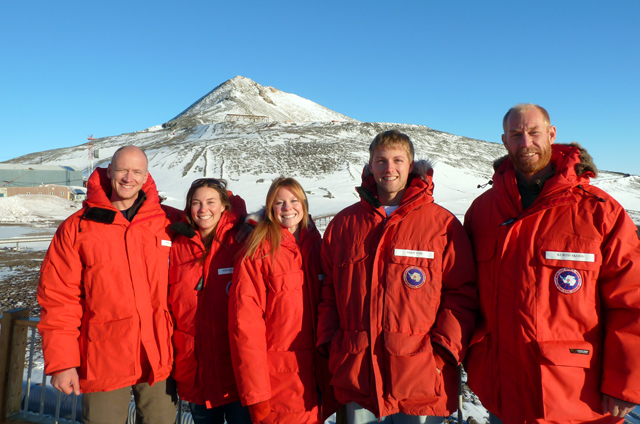
Photo Courtesy: Lindsey Vail
A Family Affair: Five family members were on the Ice together between McMurdo and South Pole stations during 2010-11. From left, Dan Scheerer, Kristina Scheerer, Adam Vail, Lindsey Vail and Kurt Skoog.
The CREAM There’s excitement at the WAIS Divide With less than a month left before the start of winter, McMurdo enters one of its hardest-working periods, with departments moving to 24-hour schedules, filled with the omnipresent sound of backing alarms on heavy machines for the massive Vessel offload — all part of the annual cycle of life at McMurdo Station. |
Home /
Around the Continent /
McMurdo Station Archives - 2011
"News about the USAP, the Ice, and the People"



For USAP Participants |
For The Public |
For Researchers and EducatorsContact UsU.S. National Science FoundationOffice of Polar Programs Geosciences Directorate 2415 Eisenhower Avenue, Suite W7100 Alexandria, VA 22314 Sign up for the NSF Office of Polar Programs newsletter and events. Feedback Form |

